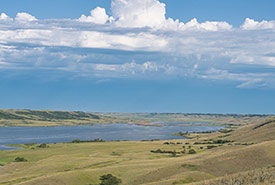Gardening with native plants this spring
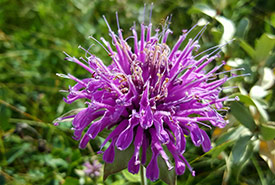
Wild bergamot (Photo by Sarah Ludlow/NCC staff)
I love to garden. I excitedly begin planning for the next year as soon as the autumn chill settles over the Prairies. I’m always impatient for spring to arrive, and it doesn’t help when the seed catalogues start arriving in November.
I find that dreaming about what I will plant and looking at seed catalogues help get me through the dreary grey of winter. Spring is often slow to arrive on the Prairies, and gardens are typically not planted here until the risk of frost has passed. The Victoria Day weekend is usually considered the benchmark.
One of my main frustrations when planning my garden or new additions to my flower beds is that many plants are not well-adapted to the climate where I live in southern Saskatchewan (typically plant hardiness zone 3). The plants grow fine throughout summer, but do not survive the sometimes –40 C temperatures of winter. This is fine if you want beds of annuals (plants that die after one year). But I am partial to perennials (plants expected to live longer than two years), and this leaves me with limited options.
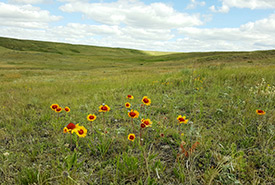
Native grassland with wildflowers (mainly blanket flower) in the foreground (Photo by Sarah Ludlow/NCC staff)
An easy and perhaps obvious solution is to plant native species. Native plants have been growing on the wind-swept Prairies for thousands of years, so assuming I can provide the preferred soil and light conditions, the plants will likely survive for many years in my yard as well.
Native plants evolved alongside native bees, butterflies and other wildlife species. As a result, native plants provide better habitat for species than do ornamental varieties. Ornamental plants are often bred to enhance their aesthetic traits rather than their nutritional value to pollinators or other wildlife.
Related blog posts
Non-native plants also may have physical, chemical and external features that native pollinators or herbivores are not adapted to dealing with. This may result in reduced abundance or occurrence of insects, such as bees and butterflies.
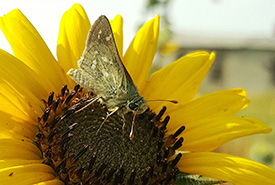
Plains banded skipper feeding on nectar from a native sunflower (Photo by Sarah Ludlow/NCC staff)
Declining insect populations have a snowball effect on ecosystems, since many species rely on insects for food. For example, during the breeding season most songbird species feed arthropods (insects and spiders) to their chicks because they have all the nutrients that growing chicks need.
In fact, a recent study investigating the relationship between breeding birds and native plants in residential yards found that native plants had more caterpillars on them than non-native plants did, and that chickadees strongly preferred to forage in areas with the most caterpillars. This means that yards with more native plants had more caterpillars and chickadees than yards with fewer native plants. The simple explanation is that the native plants provided better or more food to the caterpillars, which is a preferred food source for chickadees looking to feed their growing broods.
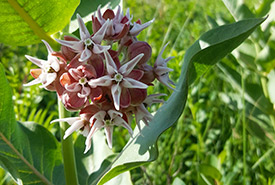
Showy milkweed (Photo by Sarah Ludlow/NCC staff)
So the message I’d like you to take away is that native plants provide better habitat for both caterpillars (butterflies) and insect-eating birds than non-native plants. This study highlights the importance of our own choices when it comes to landscaping. For me, choosing to plant native plant species in my yard has ripple effects throughout the ecosystem and provides habitat for native pollinators and birds in the process.
If you’re interested in planting native plants in your garden, make sure you do some research and find out which would grow best under your yard’s or garden’s conditions. You can find native plants at your local garden centre or native plant supplier. A quick search online will often provide a list of locations.
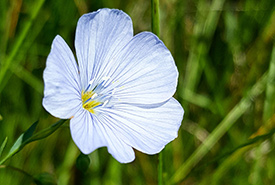
Wild blue flax (Photo by Sarah Ludlow/NCC staff)
A brief word of caution: never pick or dig up native plants from the wild! Many species have specific habitat requirements that are not easily recreated in a garden, and others may have crucial symbiotic (i.e., mutually beneficial) relationships with fungi or other plants that are hard to establish in a garden. Also, many native wildflowers have become rare in recent years and are protected, so removing them is against the law.
I’ve heard and read anecdotes describing whole meadows that looked like they were on fire because they were covered in so many western red lilies, a native species. Sadly, I’ve never actually seen this for myself. Instead I have found small patches of red lilies or individual plants in various locations, and I’m always very excited when I do!
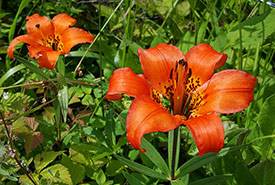
Western red lily (Photo by Sarah Ludlow/NCC staff)
Many native plants are better viewed in their natural setting, and going to see and photograph them is a great excuse to get outside and enjoy nature. Many Nature Conservancy of Canada properties provide a good place to do so.
If you want native plants in your garden, it is better to plant seeds or bedding plants bought from your local supplier and leave the wildflowers in the wild.
So when you’re planning your garden this year, consider adding some native plants. The birds and butterflies will thank you.
Resources


